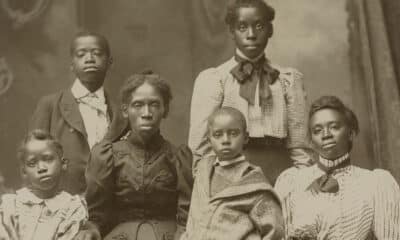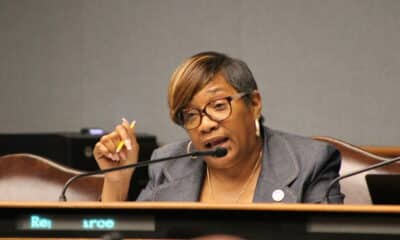Kaiser Health News
A Catch-22 for Clinics: State Bans Limit Abortion Counseling. Federal Title X Rules Require It.
by Rachana Pradhan
Fri, 26 May 2023 09:00:00 +0000
State abortion bans in Tennessee and beyond, which constrain women’s health care, have put family planning clinics at risk of losing their federal funding.
The conflict involves the Title X family planning program, which provides services to low-income people, including minors. As of 2021, more than 3,200 clinics used federal grants to supply free or low-cost contraception, testing for sexually transmitted infections, screening for breast and cervical cancer, and pregnancy-related counseling.
Federal regulations for the program, which was established more than 50 years ago to reduce unintended pregnancies, say participating clinics must offer pregnant women information about terminating pregnancies and abortion referrals on request. But following those rules puts medical providers at odds with state laws banning abortion, some of which threaten jail time, fines, or the loss of medical licenses if they help someone end a pregnancy.
President Joe Biden’s administration at the end of March cut off Tennessee’s Title X funds after determining the state health department — which oversees its clinics and was awarded $7.1 million last year — violated federal rules by not counseling patients about abortion. “Continued funding is not in the best interest of the government,” two U.S. Department of Health and Human Services officials wrote to Tennessee officials on March 20. The state had more than 100 Title X clinics as of March, according to an HHS directory.
In 2022, the federal government awarded Title X grants to roughly 90 entities, a mix of state and local governments and private organizations. Those grantees distribute funds to public or private clinics.
Federal law prohibits clinics from using Title X money to pay for abortions. However, HHS requires clinics to offer pregnant women information about prenatal care and delivery, infant care, foster care, adoption, and pregnancy termination.
In states where abortion is generally illegal, that could mean directing patients to providers in other states. But Tennessee told family planning clinics they could discuss only services that were legal in the state — effectively cutting off any talk about abortion.
Tennessee allows abortions only under limited circumstances, including to save a pregnant person’s life. State health department policies for family planning “are consistent with state law,” said Jade Byers, a spokesperson for Republican Gov. Bill Lee. Tennessee allocated state funds to replace the federal money.
Whitney Rice, director of Emory University’s Center for Reproductive Health Research in the Southeast, said failing to provide timely information and referrals for abortion “could contribute to further delays in people’s ability to access that care,” especially because women may need to travel long distances for it.
The clash over the federally funded clinics is part of the widening fallout from the Supreme Court’s June 2022 decision in Dobbs v. Jackson Women’s Health Organization ending the constitutional right to an abortion.
In Idaho, which has a near-total abortion ban, two Planned Parenthood clinics with Title X funding recently stopped giving patients abortion information and halted out-of-state referrals, according to a lawsuit Planned Parenthood and the American Civil Liberties Union filed in April against Idaho’s attorney general.
State law prohibits providers from assisting in performing or attempting to perform an abortion, and violators risk having their medical license suspended.
The clinics’ decision came after Idaho Attorney General Raúl Labrador, in a March 27 letter, said Idaho law prohibits providers from “referring a woman across state lines to access abortion services.”
That interpretation is “preventing medical professionals from providing full information to their patients,” said Mack Smith, spokesperson for Planned Parenthood Great Northwest, Hawaii, Alaska, Indiana, Kentucky.
Though Labrador later withdrew the letter, Planned Parenthood clinics there still are not referring patients out of state for abortions, Smith said.
Before Labrador’s letter, the lawsuit states, Planned Parenthood staff would furnish general information about pregnancy options, a list of abortion providers in other states and organizations that help defray patients’ abortion and related costs, and a flyer about Idaho’s abortion law. Staff would also occasionally help patients schedule care outside of Idaho. Now, “Planned Parenthood providers no longer do so.”
“When my patients require abortions, I am now forced to tell them that I am unable to help them and that I cannot say anything about their abortion options in other states,” Caitlin Gustafson, a physician who had practiced at an Idaho Planned Parenthood clinic, said in a legal declaration.
Kimberley Harris, a visiting assistant professor at Texas Tech University School of Law, said clinicians in states with strict bans worry about referring patients to other states because a prosecutor could interpret that as “aiding and abetting an abortion.”
Facilitating medication abortion in particular could “pose potential risk to health care providers,” Harris said, because a patient they refer to obtain pills out of state might then take them in a state where abortion is illegal. Medication abortion accounts for most abortions in the U.S. and involves taking a series of pills during the first 10 weeks of pregnancy.
“The federal regulation might require me to provide counseling and provide information,” Harris said of clinicians. “But if you’re telling providers that they may lose their license, or they might go to jail, or they might face a huge fine? Rightfully, they’re going to be concerned.”
As senior HHS officials travel the country, they are getting an earful about the issue.
HHS spokesperson Tara Broido said that, increasingly, “providers and patients have raised concerns about the impact that the Dobbs decision has had on access” to pregnancy counseling and referrals.
KFF Health News asked Broido which grantees have not been following the counseling and referral requirements. She declined to say.
People who use Title X’s services are disproportionately women. A report from HHS’ Office of Population Affairs said roughly two-thirds of 1.7 million patients in 2021 had family incomes at or below the poverty line. Thirty-six percent were uninsured, more than two times the national uninsured rate for adults.
The Office of Population Affairs and the Centers for Disease Control and Prevention jointly recommend family planning services that clinics are expected to follow. They include pregnancy testing and counseling.
The Title X program has been whipsawed before.
In 2019, the Trump administration barred Title X clinics from making abortion referrals. And the administration said abortion providers couldn’t share physical space with Title X clinics. The number of participating clinics subsequently dropped sharply — from 3,825 sites in 2019 to 3,031 the following year. With fewer clinics, the number of people receiving free or low-cost family planning services through the program plummeted from 3.1 million in 2019 to 1.5 million in 2020.
The Biden administration in 2021 overturned many of the Trump policies. The Biden rules remain in effect, but several states sued to block them. That litigation is ongoing.
Sarah Parshall Perry, a senior legal fellow at the conservative Heritage Foundation think tank, anticipates additional challenges to Title X rules because “states have an interest in defending their own laws and their ability to enforce their own laws.”
In Texas, which prohibits abortion with few exceptions, the nonprofit Every Body Texas oversees 154 Title X family planning clinics.
Its providers are still counseling pregnant women about options, but “that’s not to say it hasn’t been made very, very difficult,” said Stephanie LeBleu, the group’s acting Title X director.
LeBleu said the approach to counseling “can look different” from clinic to clinic. For example, clinics in rural Texas “have to be a lot more cautious about how they share information with their clients,” LeBleu said. Sometimes that means making a “referral to the referral” — such as directing patients to organizations like All-Options, which operates a national pregnancy options hotline.
ask for information on pregnancy options, “our clinics refer clients to other resources,” Karen M. Landers, chief medical officer for the Alabama Department of Public Health, said in a statement. The department declined to say what those resources are and whether clinicians worry about being prosecuted under Alabama law for providing abortion counseling or referrals.
“Clients are additionally informed of the legality of pregnancy termination in the state,” Landers wrote.
By: Rachana Pradhan
Title: A Catch-22 for Clinics: State Bans Limit Abortion Counseling. Federal Title X Rules Require It.
Sourced From: kffhealthnews.org/news/article/family-planning-clinics-abortion-counseling-state-bans-federal-rules/
Published Date: Fri, 26 May 2023 09:00:00 +0000
Kaiser Health News
Texas Measles Outbreak Nears 100 Cases, Raising Concerns About Undetected Spread
SUMMARY: A measles outbreak in West Texas has led to private school closures, overwhelming local health departments. Since the outbreak began three weeks ago, 90 cases have been confirmed, mostly in children under 18, with 16 hospitalizations. Health officials fear the outbreak will worsen, and some parents may be avoiding testing their children. The outbreak has been exacerbated by low vaccination rates, particularly in communities like Gaines, which has one of the lowest vaccination rates in Texas. Local officials are working to contain the virus through pop-up clinics, mobile testing, and educating schools, but the situation remains challenging.
The post Texas Measles Outbreak Nears 100 Cases, Raising Concerns About Undetected Spread appeared first on kffhealthnews.org
Kaiser Health News
GOP Takes Aim at Medicaid, Putting Enrollees and Providers at Risk
SUMMARY: Republicans are again targeting Medicaid, proposing significant funding cuts to finance President Trump’s agenda on tax cuts and border security. Approximately 79 million people rely on Medicaid and the Children’s Health Insurance Program (CHIP), vital for numerous hospitals and states. Amid Democratic resistance, potential cuts could include reducing federal matching funds and imposing work requirements, which critics argue adds unnecessary barriers. Historically controversial, these efforts reflect deep partisan divides over Medicaid’s role as a safety net versus a welfare program. Many Americans favor Medicaid, making proposed cuts politically sensitive. The outcome remains uncertain as GOP leaders face internal challenges.
The post GOP Takes Aim at Medicaid, Putting Enrollees and Providers at Risk appeared first on kffhealthnews.org
Kaiser Health News
An Ice Rink To Fight Opioid Crisis: Drug-Free Fun vs. Misuse of Settlement Cash
SUMMARY: Carter County, Kentucky, has controversially spent $15,000 of its opioid settlement funds on an ice rink, raising concerns about its relevance to the ongoing opioid crisis. Advocates argue that resources could be better allocated to overdose prevention, such as Narcan kits or local substance abuse programs. Brittany Herrington, a local in recovery, criticized the decision as neglecting community needs. While officials claim the rink fosters drug-free youth activities, critics note it lacks direct ties to combating addiction. Local leaders are calling for stricter oversight on how settlement funds are used, emphasizing the need for targeted support in addressing substance use disorders.
The post An Ice Rink To Fight Opioid Crisis: Drug-Free Fun vs. Misuse of Settlement Cash appeared first on kffhealthnews.org
-

 News from the South - Louisiana News Feed2 days ago
News from the South - Louisiana News Feed2 days agoJeff Landry’s budget includes cuts to Louisiana’s domestic violence shelter funding
-

 News from the South - North Carolina News Feed6 days ago
News from the South - North Carolina News Feed6 days agoModest drops in some North Carolina prices under Trump | North Carolina
-

 News from the South - North Carolina News Feed2 days ago
News from the South - North Carolina News Feed2 days agoBills from NC lawmakers expand gun rights, limit cellphone use
-

 News from the South - Arkansas News Feed6 days ago
News from the South - Arkansas News Feed6 days agoTiming out the incoming winter weather
-

 News from the South - Oklahoma News Feed5 days ago
News from the South - Oklahoma News Feed5 days agoRemains of Aubrey Dameron found, family gathers in her honor
-

 News from the South - Kentucky News Feed7 days ago
News from the South - Kentucky News Feed7 days agoEight die in flooding across Kentucky as rescues continue, governor warns of ‘wild weather week’
-

 News from the South - Florida News Feed6 days ago
News from the South - Florida News Feed6 days agoExpert discusses how deportations could cause labor shortages for several industries
-

 News from the South - South Carolina News Feed6 days ago
News from the South - South Carolina News Feed6 days agoSC Flu cases on the rise: Prisma Health Doctors speak out on how to spot symptoms, get treatment











































